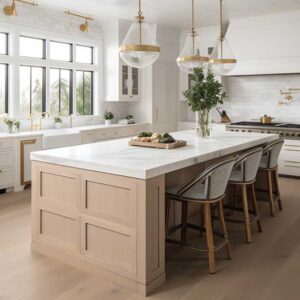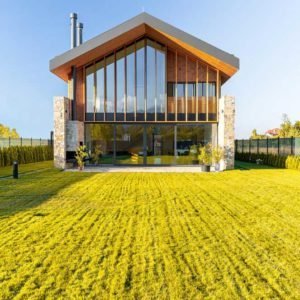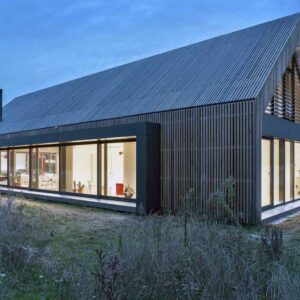Coastal landscapes, with their ever-changing moods and rhythms, have long inspired architects. The challenge lies in crafting homes that not only withstand the elements but also resonate with the beauty of the surroundings. The fusion of stone, timber, and glass has emerged as a favorite among modern designers, creating homes that are both resilient and reflective of the ocean’s majesty.


Stone – The Bedrock of Coastal Resilience
Stone, with its innate strength and durability, has been a cornerstone of coastal architecture. Its robust nature makes it ideal for homes that face the relentless power of the ocean.
Beyond its structural benefits, stone brings a tactile quality to homes. Its rugged texture contrasts beautifully with the smoothness of the sea, creating a sensory balance that’s deeply rooted in nature.
In the Fairhaven Beach House, stone pathways and foundations anchor the home to its cliffside location. This not only provides stability but also creates a sense of permanence as if the home has always been a part of the landscape.
The aesthetic versatility of stone allows it to blend seamlessly with other materials. Whether it’s the warmth of timber or the transparency of glass, stone acts as a unifying element, grounding the design.
Moreover, the stone’s thermal properties make it an excellent insulator, ensuring that homes remain cool in summer and warm in winter, further enhancing its appeal in coastal settings.



Timber – The Warmth of Nature
Timber brings a warm and organic feel to coastal homes. Its natural grains and hues echo the earthy tones of the beach, creating a seamless connection between the home and its surroundings.
In modern coastal architecture, timber is often used as cladding, adding a touch of rustic charm to exteriors. Its versatility also extends to interiors, where it can be used for flooring, ceilings, and bespoke furniture pieces.
The Fairhaven Beach House showcases the beauty of timber in its purest form. From the cantilevered study to the interior spaces, timber elements add depth and character to the design.
Beyond aesthetics, timber offers functional benefits. It’s a renewable resource, making it a sustainable choice for eco-conscious homeowners. Its insulating properties also enhance energy efficiency, further elevating its appeal.
The tactile quality of timber, combined with its visual appeal, makes it a favorite in coastal homes. Whether it’s the sound of footsteps on a timber deck or the feel of a wooden balustrade, timber engages the senses, enhancing the overall living experience.


Glass – Framing the Ocean’s Beauty
Glass, with its transparency and elegance, plays a pivotal role in coastal architecture. It acts as a bridge, connecting the indoors with the mesmerizing beauty of the ocean.
Large glass facades, as seen in the Fairhaven Beach House, offer panoramic views of the surroundings. They transform living spaces into ever-changing canvases, where the play of light, shadows, and reflections creates a dynamic visual experience.
Beyond its visual appeal, glass brings a sense of openness to homes. It blurs the boundaries between the inside and the outside, creating spaces that feel expansive and connected to nature.
Modern advancements in glass technology also mean that homes can enjoy unobstructed views without compromising on energy efficiency. Double-glazed windows and UV coatings ensure that interiors remain comfortable, regardless of the weather.
In essence, glass is more than just a material. It’s a medium through which homeowners can engage with the landscape, experiencing the rhythms of the ocean from the comfort of their homes.

The harmony of stone, timber, and glass in coastal architecture is a testament to the power of design. These materials, each with its unique properties, come together to create homes that are not only beautiful but also in tune with their surroundings. The Fairhaven Beach House stands as a beacon of this design philosophy, showcasing the endless possibilities that arise when nature and architecture converge.












